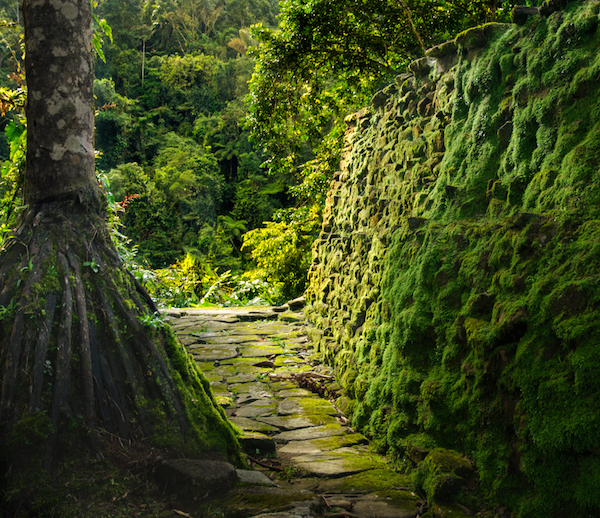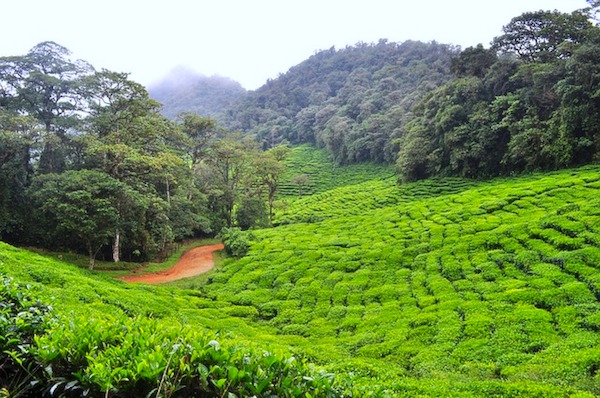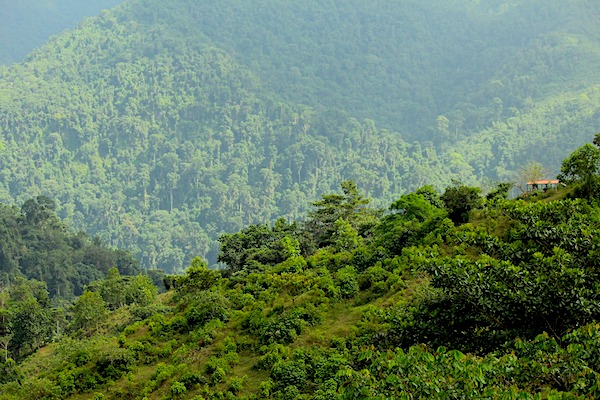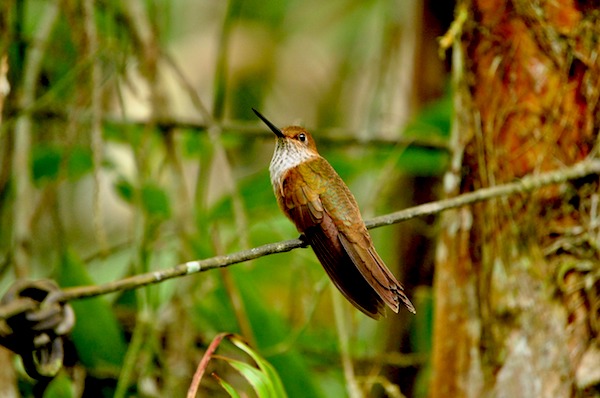If you’ve ever wished you could have seen Machu Picchu before it became the #1 tourist attraction in Peru, or known how it felt to be an explorer discovering the remains of an ancient civilization for the first time, now is your chance. Deep in the rainforests of Colombia, the ruins of a lost city have only recently been rediscovered.
The Ciudad Perdida -- meaning “Lost City” -- is what remains of an ancient Tayrona settlement originally called Teyuna, with buildings dating back as far as 800 AD. This means that the the Ciudad Perdida is actually 650 years older than Machu Picchu, and remained untouched and abandoned for far longer.
In 1972, Ciudad Perdida was finally discovered by outsiders.

The ancient path to The Lost City.
A group of men - believed to have been bird hunters - stumbled upon the ancient ruin, and soon after realizing what they had found, began to ransack the site. At the time the Ciudad Perdida was almost entirely swallowed up by the jungle, but as the hunters hacked their way through - chopping away at plants and pulling out rocks, they finally found what they were looking for: gold.
The Tayrona had left golden jewelry and idols for their dead to take with them into the afterlife, and the hunting group quickly took advantage, stealing most of what they found..
News of the gold brought more fortune seekers flocking to the sight until finally, after three years, the Colombian government took control of the Ciudad Perdida and began to instate protective measures. Soon afterwards, the Ciudad Perdida was forgotten a second time.
Tourism to Colombia was about to be kept at bay by a different force.
Political conflict and widespread trade of narcotics made the Sierra Nevada too dangerous to visit. In the overgrown jungle, this threat was so uncontrollable that the Colombian government actually shut down the area and forbade access to the Lost City.
Luckily, times are much different today. You can travel to Colombia’s lost city once again and it is very safe -- the government actually sends military units to guard the campsites and city itself.
But what is Teyuna like today?

Trekking to the Lost City of Teyuna
One good thing that came from the Lost City’s rough past is that the Ciudad Perdida remains almost completely untouched today. There are no buses, trains, or bicycle tours to Teyuna. The only way it can be reached is on foot -- exactly how explorers first discovered the site.
Completing the grueling, multi-day trek through the mountainous jungles of the Sierra Leone is a challenge, but well worth the reward.
In order to preserve the trail to Teyuna, and the sanctity of the archaeological site itself, the government only allows 6 tour companies to lead treks through to Colombia's Lost City. As a traveler, you must visit Ciudad Perdida on a tour with one of these companies - you cannot visit independently.
While each of these tour operators offer essentially the same itinerary - a trek to the Ciudad Perdida and back - the kinds of tours they offer differ slightly, and for that reason it’s important to research what exactly you’ll be getting (or won’t be) on your Lost City trek.
The good news is that you’re in the right place -- Travelstride can help you compare Ciudad Perdida treks side by side, as well as provide insight and reviews of the companies that run them to make sure you find the right tour for you.
Before you book your visit to Ciudad Perdida, here are some things you need to know about trekking tours to Teyuna:
Lost City treks last anywhere from 3 to 6 days, depending on how quickly your group expects to move and how much time you spend stopping at Kogi indigenous villages along the way.
We recommend tours on the longer side (especially if you are not in peak physical condition) so that you are not rushed. The trek to Ciudad Perdida is a fixed distance, and if you allow yourself a couple more days, you will really be able to soak in the feeling of being completely alone in a pristine jungle. Spending more time on the trail also has the added bonus of allowing you more time to spend with the Kogi.
Who are the Kogi?
The Kogi are direct descendants of the Tayrona (sometimes spelled Tairona) - the people who built the Lost City. Their isolated communities live in a very similar fashion to the way the Tayrona did. They are a farming people, and live in villages made of mud and stone huts with thatched roofs.
Both men and women wear a similar style of white clothing, with the exception of the fact that women wear beaded necklaces and men carry a satchel at all times. These people have strong spiritual beliefs and see themselves as protectors of the Sierra Nevada and the Ciudad Perdida.
The Kogi speak their own Chibchan language (meaning it is indigenous to the area), although many of the younger Kogi also speak Spanish. For the most part, the Kogi are appreciative of the tourist interest in their heritage and culture, and they welcome the tourists they encounter.
On your guided tour to the Ciudad Perdida, you might be led by a member of the Kogi, and are sure to be taught a great deal about their traditions. You may even meet a Mama, or a Kogi shaman.

A tea farm in the Sierra Nevada de Santa Marta.
Choosing Your Ciudad Perdida Trek
As previously mentioned, the main decision you will have to make when deciding between different tours to Ciudad Perdida is how long you want to be trekking. Shorter treks require a higher level of physical fitness, since you will be covering the same trail at a quicker clip.
You will be responsible for carrying only your personal items - usually a small or mid size backpack - on most tours to the Lost City. Mules will carry camp supplies and food on your journey to the Ciudad Perdida, and a chef will trek ahead of the group to prepare a delicious, hot meal for you at your campsite.
Any traveler to the Ciudad Perdida should still prepare for relatively rough camping conditions. Be prepared to sleep in hammocks, bunk beds, or sleeping bags, depending on your tour - and expect some unpredictable weather!
Another potential differentiator when choosing your tour is whether or not your guide can speak English. Most guides on the Ciudad Perdida trek speak Spanish so if you are an English speaker, you will hear most of what they say through a translator. You may find this irritating, or it may not matter to you if the guide is good enough - again, reviews are the best way to get impartial advice about which tour guides are the best.

Planning Your Ciudad Perdida Jungle Trek: Logistics & What to Expect
There is a reason that many of the treks to Ciudad Perdida are considered physically extreme. Colombia’s segment of the Sierra Nevada de Santa Marta is difficult terrain -- a mountain range made up of jagged rocks coated in a thick layer of tangled jungle -- and so it makes sense that the region remains remote even today, and almost untouched by modern man.
As a result, prepare to adopt a little bit of an Indiana Jones attitude when you have to hack through thick foliage with a machete, or scramble up some steep, rocky paths.
All of this physical exertion (on shorter tours, you could be walking for up to seven hours each day), combined with the heat of the Colombia, means you will be sweating for most of the day. Luckily, there are plenty of great rivers and swimming holes along your trek, but it is still best to be prepared and wear synthetic, sweat-wicking materials on your hike.
Fast drying clothing is especially important because of the Sierra Nevada’s humidity and the ever present threat of rain. You will likely be caught in a drizzle at least a couple of times on your trek, so you will appreciate having warm, dry clothing when the temperature drops at night!
When to Go?
The temperatures are most pleasant during the dry season - between December and March. This is widely considered the best time to go on a Ciudad Perdida trek. During the dry season, there is less of a chance that you will get rained on, and the rivers you have to cross to get to the Lost City will be at their lowest and easier to cross. The ungroomed trail will also be less muddy and dangerous during the dry season.
What to Bring?
It goes without saying that you should also pack good hiking clothing, and a sturdy, preferably waterproof, backpack. Wear solid hiking boots that you’ve already broken in, but pack comfier shoes to let your feet rest in at camp.
A hat, reusable water bottle, towel, sunscreen, bug spray, toilet paper for campsites, some cash, and some Advil or light pain medicine for soreness are also good things to bring.
Although not necessary, we also highly recommend bringing a camera and a pair of binoculars! You may encounter some incredible wildlife on your hike. The Sierra Nevada de Santa Marta is home to many tropical birds and exotic mammals, like the tapir, and you will appreciate having binoculars to better observe them in their natural habitat.

Seven species of hummingbird are only found in the Sierra Nevada de Santa Marta mountain range.
An Untouched Wonder: Experiencing Colombia’s Lost City
After all of your extensive planning and preparation, you finally make it: The Ciudad Perdida. Arriving in Teyuna, even the bare bones of this forgotten city are an impressive sight. The jungle has reclaimed much of what used to exist, and the graverobbers have further altered this ancient city, but there is an air of mystery to the place, as well.
Nobody knows what it lies under the ruins, but what is certain is that there is something below. Archaeologists predict that only 10% of the Ciudad Perdida has been excavated, and you get a sense of this unknown when you walk along the raw and unaltered Teyuna steppes, clear skies above you and the dark chasms of jungle below.
There are no reconstructions here, or roped-off areas, or plastic placards pointing out important buildings and explaining their significance. The secrets of the Tayrona hang heavy in the air, and no one knows what lies just under the surface.
What there is left to see is still incredible. The foundations of more than 200 structures are visible -- there are traces of houses, terraces, staircases and plazas under your feet, and you can see how the Tayrona expertly carved the stonework of these structures.
There are also other artifacts on site, such as massive stone maps and tools used to grind cornmeal and make food. Your tour guide uses these remainders of a once vibrant and busy city to bring the idea of Tayrona society to life, and you begin to learn about a history very few people know.

